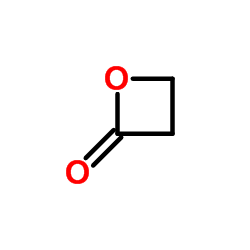β-Propiolactone

β-Propiolactone structure
|
Common Name | β-Propiolactone | ||
|---|---|---|---|---|
| CAS Number | 57-57-8 | Molecular Weight | 72.063 | |
| Density | 1.2±0.1 g/cm3 | Boiling Point | 162.0±0.0 °C at 760 mmHg | |
| Molecular Formula | C3H4O2 | Melting Point | −33 °C(lit.) | |
| MSDS | Chinese USA | Flash Point | 35.0±16.1 °C | |
| Symbol |


GHS06, GHS08 |
Signal Word | Danger | |
|
Induction of Local Secretory IgA and Multifunctional CD4⁺ T-helper Cells Following Intranasal Immunization with a H5N1 Whole Inactivated Influenza Virus Vaccine in BALB/c Mice.
Scand. J. Immunol. 81 , 305-17, (2015) Avian influenza subunit vaccines have been shown to be poorly immunogenic, leading to the re-evaluation of the immunogenic and dose-sparing potential of whole virus vaccines. In this study, we investigated the immune responses after one or two doses of intram... |
|
|
A simple method for measuring porcine circovirus 2 whole virion particles and standardizing vaccine formulation.
Biologicals 43(2) , 79-83, (2015) Porcine Circovirus 2 (PCV2) is involved in porcine circovirus-associated disease, that causes great economic losses to the livestock industry worldwide. Vaccination against PCV2 proved to be very effective in reducing disease occurrence and it is currently pe... |
|
|
Quantitative determination of the infectivity of the proviral DNA of a retrovirus in vitro: Evaluation of methods for DNA inactivation.
Biologicals 37(4) , 259-69, (2009) All viral vaccines contain contaminating residual DNA derived from the production cell substrate. The potential risk of this DNA, particularly when derived from tumorigenic cells, has been debated for over 40 years. While the major risk has been considered to... |
|
|
A fluorescence high throughput screening method for the detection of reactive electrophiles as potential skin sensitizers.
Toxicol. Appl. Pharmacol. 289 , 177-84, (2015) Skin sensitization is an important toxicological end-point in the risk assessment of chemical allergens. Because of the complexity of the biological mechanisms associated with skin sensitization, integrated approaches combining different chemical, biological ... |
|
|
Polymer brushes interfacing blood as a route toward high performance blood contacting devices.
Macromol. Biosci. 15 , 636-46, (2015) In the current study, well-defined polymer brushes are shown as an effective surface modification to resist the adhesion of whole blood and its components. Poly[oligo(ethylene glycol)methylether methacrylate] (poly(MeOEGMA)), poly(hydroxyethyl methacrylate) (... |
|
|
Treatment of influenza virus with beta-propiolactone alters viral membrane fusion.
Biochim. Biophys. Acta 1838(1 Pt B) , 355-63, (2014) Beta-propiolactone (BPL) is commonly used as an inactivating reagent to produce viral vaccines. Although BPL has been described to chemically modify nucleic acids, its effect on viral proteins, potentially affecting viral infectivity, remains poorly studied. ... |
|
|
Matrix photochemistry, photoelectron spectroscopy, solid-phase structure, and ring strain energy of beta-propiothiolactone.
J. Phys. Chem. A 113(15) , 3662-72, (2009) The four-membered heterocyclic beta-propiothiolactone compound was isolated in a low-temperature inert Ar matrix, and the UV-visible (200 < or = lambda < or = 800 nm) induced photochemistry was studied. On the basis of the IR spectra, the formation of methylk... |
|
|
Poly(lactide-co-glycolide) microspheres: a potent oral delivery system to elicit systemic immune response against inactivated rabies virus.
Vaccine 27(15) , 2138-43, (2009) Rabies is an endemic, fatal zoonotic disease in the developing countries. Oral vaccination strategies are suitable for rabies control in developing countries. Studies were performed to investigate the suitability of poly(lactide-co-glycolide) (PLG) microspher... |
|
|
A sensitive cell-based assay for the detection of residual infectious West Nile virus.
Vaccine 25(39-40) , 6872-81, (2007) Ensuring complete viral inactivation is critical for the safety of vaccines based on an inactivated virus. Detection of residual infectious virus is dependent on sensitivity of the assay, sample volume analyzed and the absence of interference with viral infec... |
|
|
Validation of betapropiolactone (BPL) as an inactivant for infectious bovine rhinotracheitis (IBR) virus.
Res. Vet. Sci. 85(3) , 589-94, (2008) Infectious bovine rhinotracheitis (IBR) virus causes vulvovaginitis, abortion and respiratory disease in cows and heifers. Betapropiolactone (BPL) is a disinfectant, effective against bacteria, fungi and viruses. It is also used to prepare inactivated vaccine... |